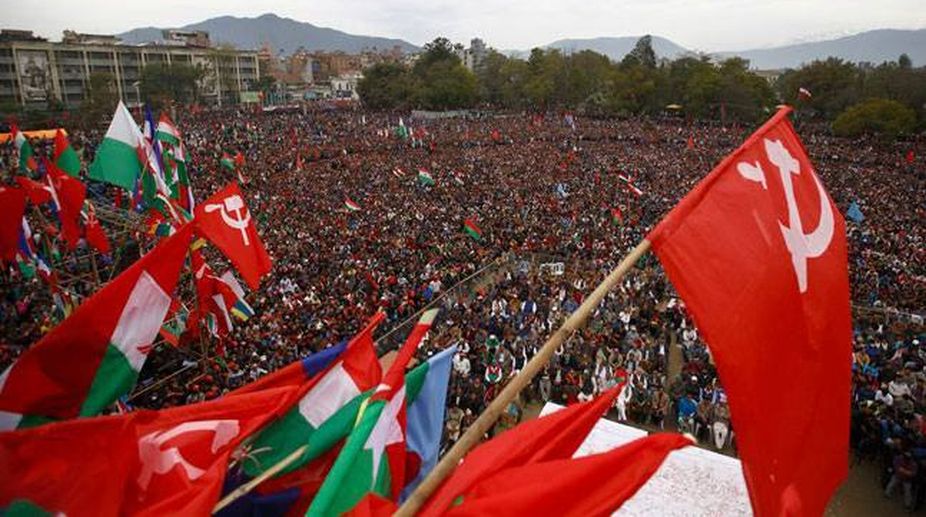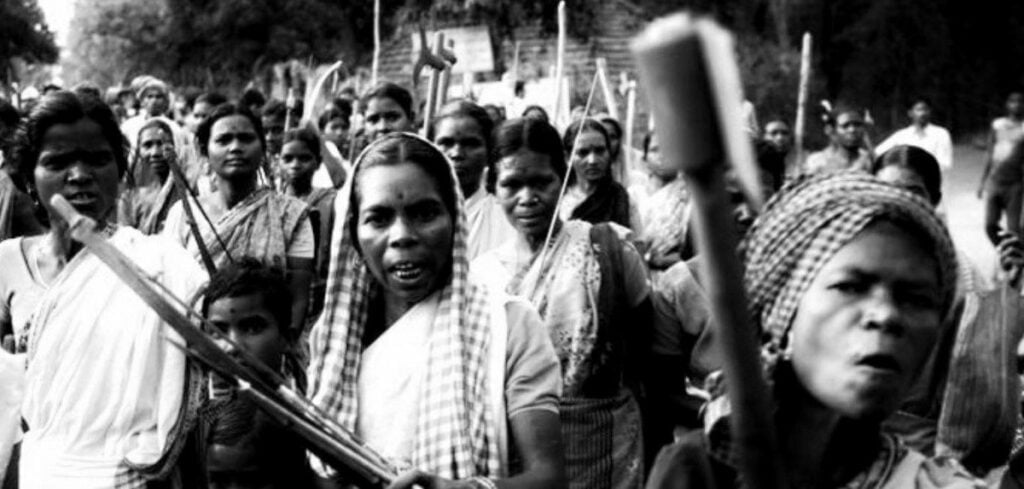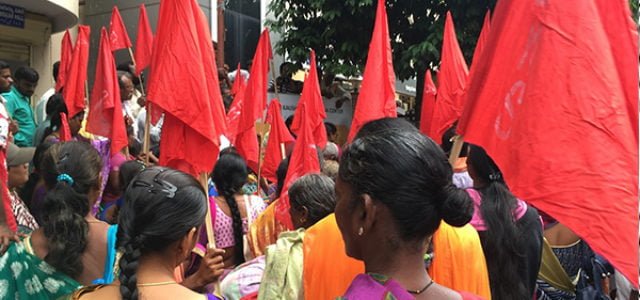A lot has been written about the origin, characteristics and influence of the Naxalbari movement. However, a perceptive critique of literature exposes the glaring absence of women’s participation and their concerns in the movement. Within this context and cognisance, Mallarika Sinha Roy pens her book ‘Gender and Radical Politics in India: Magic Moments of Naxalbari (1967-1975)‘. It has been over ten years since the book came out, but the discourse around women’s contribution to the movement and others similar to it has been limited, and slowly trickling in at best.
This investigation of a prominent postcolonial South Asian movement using gender as an analysis attempts to understand the ‘silence’ and gender politics of the movement. As Roy adeptly points out, despite the clashing beginnings of the second wave of feminism and the Naxalbari movement, there was little to no association between feminist ideologies within the movement.
It explores Naxalbari using a gendered lens to create an articulation that forms the nexus of historical happenings and the fantasy of the movement. Roy employs different references to support her argument- this includes but is not limited to government pamphlets, oral narratives, creative literature, archival material and films.
The book’s subtitle, ‘Magic Moments of Naxalbari‘, comes from one of Roy’s initial sources and consequently emerged as a frequent theme across many of her interviews with the women who had participated in the movement. It explores Naxalbari using a gendered lens to create an articulation that forms the nexus of historical happenings and the fantasy of the movement. Roy employs different references to support her argument—this includes but is not limited to government pamphlets, oral narratives, creative literature, archival material and films.
Nevertheless, as Daniel J.R. Grey put it, ‘Oral history is at the heart of the book’. It is probable that this technique of qualitative data collection emerged from the author’s inability, despite extensive attempts, to get hold of official documents about the movement. In spite of this, the book is well-researched and comes with an indispensable anthropological validation that makes it an essential read for anyone navigating the fields of gender, postcolonial movements and the Naxalbari movement itself.
In fact, as put forth by the author herself, these various sources help make the text more nuanced by allowing us to access the movement from various levels of activism, ideology, cultural expression, academic analyses and more.

Magic Moments of Naxalbari
The book focuses on two specific areas: the northern West Bengal and the Birbhum district in southern West Bengal. Keeping at par with the significant analytical themes, Roy focuses on Naxalite women from different castes, classes and tribal backgrounds that offer critical intersectionality to the discussion. It further studies the constant subjugation and resistance that layers women’s lives from different caste and class backgrounds to provide rich insights into the lives of all Naxalbari women.
The author has a three-pronged agenda concerning this body of work. First, to acknowledge and highlight the various gender-based subjugations in the specific context of the Naxalbari movement. Second, to illustrate and examine women’s experiences from their participation in the movement and their subsequent interpretations. Third, to use gender as a category of analysis to fill the gap created by previous bodies of literature.
Also read: Revisiting Manto’s Partition Stories Through The Lens Of Gender
To do this, the book has seven chapters beyond the preface and epilogue. The first chapter is introductory and lays down the history and impact of the Naxalite movement while taking the readers through the major analytical themes and presenting gender as a category of analysis. In the second chapter, Roy presents the argument for redefining the existing academic historiography to be able to engage with ‘this radical movement as a social event.’ This is important so that we can delineate from the existing historic records that present a heterogeneous view on the whole issue.

From this gendered location of history, Roy moves on to the questions of women’s work and agency in the third chapter. In this section, the author brings up the question of multiple patriarchies and how power, politics and masculinity are deeply intertwined. She specifically raises points about urban, middle-class masculinity and contextualises the subjugations faced by women at different hierarchical levels. In the fourth chapter, the author attempts to acknowledge the various connotations of ‘gendered memory’ in an exercise to reinterpret the overall narrative around the movement. She takes the reader through the romantic manifesto of the revolution, the mechanisms of forgetting and remembering and speaking silences in detail.
It traces communist movements locally (West Bengal) and globally (Russia, China, Vietnam and Cuba, amongst others). The subsequent historical path is the Naxalite vision and internationalism. The third trajectory, as proposed by the author, is concerned with the impact of the movement in South Asia, and specifically, India.
In the fifth chapter, Roy discusses the experiences and perceptions of women in an attempt to understand political activism and acts of agency. This is done using the words of the women who were interviewed. The author provides detailed transcripts for the reader to understand better, the context in which the conversations are placed and their subsequent responses.
Nearing the end of the book, the sixth chapter is titled, ‘Weapons and Wounds’ and offers a provocative account of the gendered violence in the movement. It takes the reader beyond the binaries of State versus Naxalite violence and raises the questions of violence and gendered militancy. This is done skillfully and Roy’s well researched and conceptual argument must be appreciated.
The final chapter offers a thoughtful conclusion that puts forward the historical courses of Naxalbari through relative contexts. It traces communist movements locally (West Bengal) and globally (Russia, China, Vietnam and Cuba, amongst others). The subsequent historical path is the Naxalite vision and internationalism. The third trajectory, as proposed by the author, is concerned with the impact of the movement in South Asia, and specifically, India. The chapter also outlines ‘feminist mappings of the Naxalbari movement’ and discusses the women’s question within these radical frameworks.

Women and the Naxalite Movement
The existing literature on the Naxalite movement, though thoughtful and credible in all other spheres, comes with an evidently large missing gendered aspect. Roy engages with some of the literature in the field to highlight these ‘gender-blind’ renditions of history. And in doing so, she questions the absence and silences of these gendered issues and how they have been marginalised for so long, from so many prominent academic texts. Roy adopts the documents of memory and the documents of fiction to weave women into these historical narratives. She is, therefore, able to force the reader to urgently and innovatively contest the ‘academic historiography’s monopoly over “reality”.
Roy has successfully been able to locate the gendered history of the Naxalite movement in her insightful book. She is able to help the reader rethink how gender linkages respond to political ideologies and movement strategies. It can also explain not only why women’s agency has been missing but also how this absence has been preserved. The book ends on a promising note of a ‘sisterhood of resistance’ and of the importance of asking relevant questions, even if they do not come with satisfactory answers.
Also read: Book Review: Bibi’s Room—Hyderabadi Women and Twentieth Century Urdu Prose
This piece offers the reader an extensive understanding of the lives of the women who participated in the Naxalite movement- an area of discussion that has been grossly neglected in the past. The women’s oral histories and personal recollections further lend significant and impactful character to the book. These, along with the poems, references to visual and cultural material help bring the book to life. The book lends a crucial framework to help scholars engage with the politics of gender within a social movement and enquire into the impact of gender on social and political movements. Roy has not only been able to fill the gap in existing literature but also create a space that carves a significant precedent for similar studies.
About the author(s)
Muskan is a socio-economic researcher interested in women studies. She is working as a Research Associate at a consultancy focusing on the informal economy. She believes a better world is coming.




